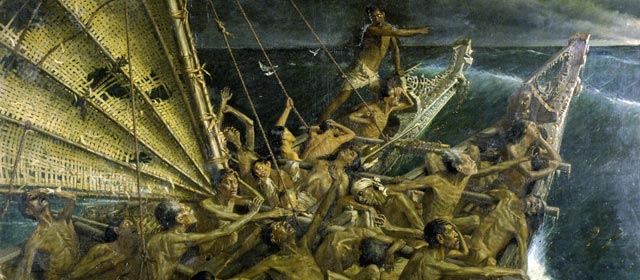Story summary
Early ideas
When Europeans discovered New Zealand, they wondered about the origins of the Māori people. James Cook noticed that Polynesians and Māori had similar appearances and cultures. He believed they had migrated from the islands of South-East Asia. It is now agreed that Māori are Polynesians whose ancestors lived in the Taiwan region.
Some early visitors, who studied items such as headdresses and carvings, thought Māori ancestors might be ancient Greeks or Egyptians. One artist painted a Māori as a Roman warrior. Christian missionaries suggested that Māori ancestors were Jewish, belonging to the Lost Tribes of Israel.
The Aryan theory
In the 1850s scholars discovered that most European languages had developed from Sanskrit, the ancient language of India. It is still believed that Europeans and Indians share ancestors, known as Aryan or Caucasian. Ethnologists such as Edward Tregear claimed that Māori, too, had come from India. He found similarities between Māori and Sanskrit words and symbols.
The Great Fleet story
In the 19th century many scholars recorded different Māori stories about reaching New Zealand from Polynesia. But one man, Percy Smith, calculated from listening to Māori histories that they had migrated together in 1350 CE, in one ‘great fleet’ of seven canoes. According to Smith, they had then conquered the Moriori, who he said were a primitive Melanesian race already living in New Zealand. Smith’s story was accepted for over 60 years. It was popular because many believed that European settlers were the next ‘superior’ people, who would take over from Māori.
New understanding
From the 1920s scientists proved that Chatham Island Moriori, like Māori, were descendants of the original Polynesian settlers of New Zealand. Moriori had migrated to the Chatham Islands some time after 1300 CE, possibly around 1500.
In the 1960s errors were found in Percy Smith’s research for the Great Fleet story. Recent scientific evidence includes DNA analysis, and radiocarbon dating of archaeological sites. It is now believed that Māori arrived at different times, from several points in East Polynesia, in the late 13th century.





